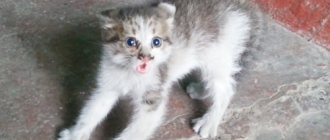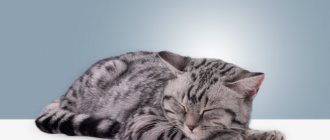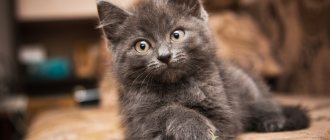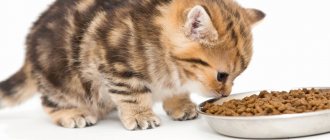Fur belly
No matter how alluring your soft fur belly may seem to you, don’t touch it unless necessary. This is a vulnerable spot; most cats don't like to be touched.
Many dogs love belly rubs, but cats are not dogs. With a high probability they will attack the hand that decides to commit such blasphemy. When a cat is resting and showing you its belly, it means that it is relaxed and trusts you. Make no mistake: this is not an invitation for your hand. Although there are also cats that allow the owner to do this. But rest assured: the pet is simply enduring, there is no talk of any pleasure.
Black fittings and open shelving will be a thing of the past. The main trend is comfort
Everyone fears Tutankhamun's new curse: Giza Museum wants to move the mummy
Spitbank Fort could become private property for $5.2 million
Why cats love affection
The skin of cats is extremely sensitive due to the presence of vibrissae - whisker-like hairs. These hairs are much smaller and thinner than the whisker whiskers, but they are also organs of touch. If you stroke a cat in the direction of the growth of the whiskers, it will give her pleasure. Stroking against the grain, on the contrary, will lead to a feeling of discomfort. If your cat's fur is coarse and short, it may even cause pain.
Another reason why cats love stroking is that in those areas of the body, stroking which the owner gives the cat maximum pleasure, there are glands that exude secretions. With this secret, pets mark their territory, “their” objects and, of course, their owners. Thus, by stroking the cat in such places, the owner, as it were, “self-marks.” The cat perceives such actions on the part of the owner as a sign of special trust, which gives her special pleasure.
It is not advisable to stroke a cat against its grain.
The most sensitive areas of cats
The favorite places for stroking are those areas of the cat's body where the aforementioned “odorous” glands are located, or rather those where there are the largest number of them. For this reason, the most “pleasant” places are:
- The middle of the forehead located between the ears.
- The area located between the ear and eye. This area in cats is somewhat “bald” due to the sparser fur than on the rest of the body. Moreover, it is rarer not only in adults, but also in small kittens. It is assumed that this is where the maximum number of “scent” glands are located, with which the cat marks its property.
- Angle between nose and lips. These are the very places where cat whiskers grow. This is the area where a cat most often rubs against household furniture and its owner’s legs.
- Lips and chin: scratching these places gives cats the most pleasure.
- The lower part of the back located at the base of the tail.
What areas are most sensitive in cats?
There are no scent glands on the abdomen, but this area is very sensitive to touch. And only if the pet has maximum trust in its owner will it lie on its back and allow it to stroke its belly.
Warnings
- It is possible that your cat becomes overly agitated when being stroked due to hypersensitivity syndrome, which is common in cats. If this is the root of the problem, petting and scratching only cause pain instead of pleasure. There are various ways to overcome this problem, including (but not limited to) clicker training, more play time, and medications.
- Do not try to pet your cat while she is eating or busy in her litter box, as she may perceive this as an invasion of her personal territory and scratch you.
- Sometimes cats may playfully nip or lightly scratch your hand and wrist. While remaining calm, firmly say “Stop!” Your cat will most likely stop and look at you. Take this moment to remove your hand and pet the animal elsewhere, continuing to build a bond between you.
- If an animal catches your hand with its claws, do not pull your hand back, otherwise you will end up with one or more long, ragged scratches on your skin. Allow the cat to pull your hand towards him. In such cases, cats usually bite the hand lightly and release it, pulling it close enough.
Almost every family has pets, and cats probably take first place among people's favorites. However, there are many contradictory signs and beliefs associated with this animal. Some believe that a cat brings happiness, others, on the contrary, that it attracts misfortune. And one of the most famous superstitions says that cats should not be stroked by pregnant women, as supposedly the child will be very hairy.
According to other statements, this should not be done, because the baby may be born sick. And there is some truth in this, but not because a cat can somehow magically influence the development of the fetus. When figuring out why you shouldn’t pet cats, it’s better to base yourself not on superstitions, but on a scientific point of view.
Firstly, this animal can be a carrier of various diseases, for example. The bacteria of this infection, found on a cat's fur, are easily transmitted to humans, just by stroking your pet. And in the early stages of pregnancy, toxoplasmosis pathogens can cause irreparable harm to the unborn child.
Secondly, worms, which are present in almost all animals, can be dangerous. They are transmitted to humans as easily as toxoplasmosis, so after you pet your cat, wash your hands very thoroughly.
Fourthly, you cannot pet cats, because... they can become pathogens of strong. Only strong medications can cope with this scourge, the use of which can have a detrimental effect on human health, and especially on the health of the expectant mother.
This is why pregnant women should not pet cats, and if you cannot refuse your pet affection, then after any contact with the animal, wash your hands thoroughly and periodically show it to the veterinarian.
Anything that can meow and purr loves stroking. However, if a cat reacts ambiguously to such manipulations, then this is a clear sign that its owner is doing something wrong. Meanwhile, you should know that there are especially sensitive places on the cat’s body, stroking which can give any cat extraordinary pleasure.
First, it should immediately be said that stroking a stranger and the owner of a cat are not the same thing. If the cat's owner is allowed to touch almost all parts of the body, giving the cat pure pleasure, then the same touches from a stranger can be perceived completely differently.
Pleasure and benefit
Few people know how to properly pet a cat, despite the fact that such a pet lives in almost every third home.
Many pet owners do not even suspect that there is a method by which to pet their pet. Therefore, the owner’s affection is often perceived by the cat differently from what a person expects.
In this article, you will learn how to properly pet a cat to further please your pet and benefit from it yourself.
There has never been a single creature on the planet that does not love affection. Just like humans, animals need care and attention. Cats, like no other animal, love to be petted. Gentle stroking not only brings pleasure to the cat, but also has a beneficial effect on the health of its owner.
Important! The moment you caress your kitten, your blood pressure stabilizes, your nervous system calms down, and your stress level decreases.
But you should definitely take into account the desire and mood of your cat, because the animal does not always want to be stroked. Cats, like people, have different morals and characters. While some people love to be petted and are ready to sit in their arms for hours on end, others only need five minutes to get their fill of affection, after which they begin to pull out, scratch, and sometimes bite.
Important! In order not to create discomfort for the animal, it is correct to pet the cat when he wants it, and stop such actions when the animal openly demonstrates reluctance to your caresses.
Scientists, studying the behavioral characteristics of the cat family, conducted many experiments and tests regarding the question of how to properly pet a cat. After years of comparing the behavior and reactions of cats, they came to the conclusion that there are certain behaviors in animals that will determine whether they are predisposed to affection by their owner for a given period of time:
- Reach out to your cat. If he doesn’t react to you in any way and avoids touching you in every possible way, you shouldn’t anger the animal. Most likely, he is not in the mood for tenderness right now.
- If you extend your hand and the cat begins to rub against it, you can gently stroke it behind the ear or in the chin area.
Important! To make this “procedure” enjoyable for your pet, determine his favorite places for petting.
There are certain points on the human body, pressing on which during a massage allows you to relieve stress from the muscles and get maximum relaxation of the body. Your pets are no exception to this situation. They also have certain areas on the body, massaging which even the most stubborn representative of the breed will not remain indifferent.
Neck and ear area
Ears are a favorite place for petting dogs and cats. Try the following steps and you will see your pet’s grateful eyes:
- Using gentle massaging movements with your fingers, stroke the kitten in the ear area.
- Smoothly move from the center to the edges of the ears.
- Slowly lower yourself to the back of your head and massage with gentle movements.
From such caresses your pet will simply stretch out in bliss.
The animal cannot properly scratch these areas of the body with its paws, so most cats love it when their owners give these areas a gentle massage. If you adhere to the following recommendations, you will see in practice that you are now petting your cat correctly:
- Use your fingertips to follow your pet's chin. Notice how he stretches his neck forward in pleasure.
- Slowly, going through the fur, go down to the chest area.
Important! Movements and pressures should not be sharp or intense, so as not to damage the animal’s larynx.
Back area
Since the cat family walks on four legs, the entire load from their movement goes to the spine. Therefore, they often develop a disease of this part of the skeleton.
If your cat falls asleep on your lap, help her feel completely relaxed and cared for:
- Pet your pet from the neck to the base of the tail.
- Using light pressure with your fingertips, move from the back of the head to the base of the tail along the spine to relieve tension from the back.
Important! When petting, try not to touch the tail, as cats do not like this. Rest assured, this is the correct way to pet a cat.
Cheek area
Want to cheer up your kitten? Caressing the cheeks for this, as with a person, is best suited:
- When the animal is calm, use gentle touches to stroke the area under the animal's eyes.
- Smoothly move to the cheeks - they are located behind the whiskers in cats.
In response to your actions, you will hear the cat’s satisfying purr.
How to find an approach to someone else's cat
If you come to visit, and the cat living there has never seen you, do not rush to pick it up, stroke it and throw it in the air. Don't touch her, let her smell you herself. Although most cats show interest in a new person who appears on their doorstep, only a few are not opposed to him immediately starting to stroke and cuddle them.
To earn your animal's trust, play with his favorite toy. If after this you begin to stroke it, and it does not try to escape, then in the process do not forget to pay attention to the signs that it sends you (see above).











